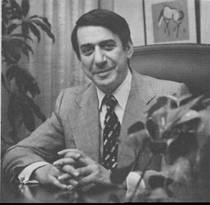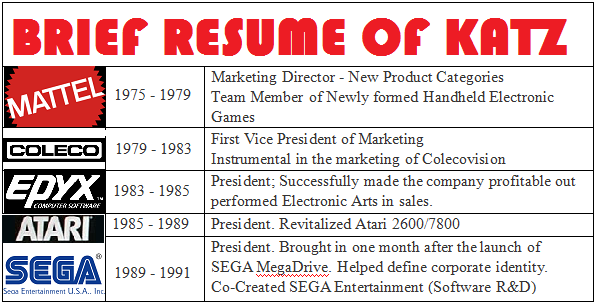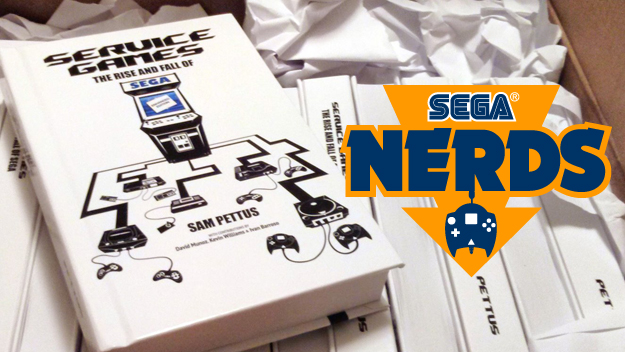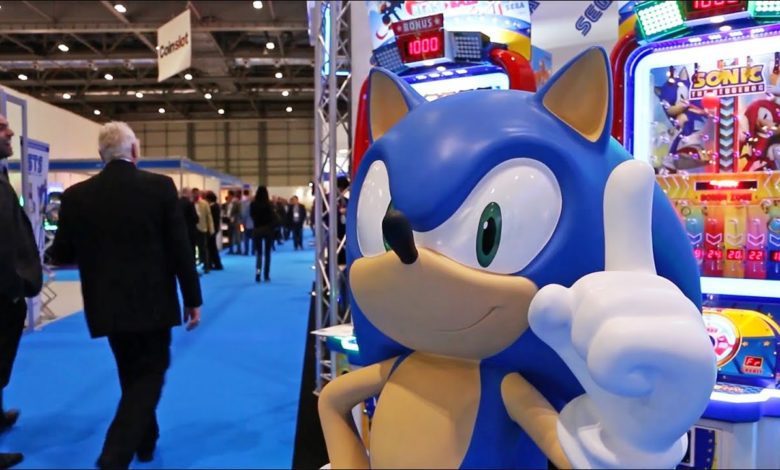
Know your History: The Katz Report
SEGA is a dynamic organization. Talent is constantly being nurtured and brought in the organization. These days, the company seems to be more prolific with bringing talent into the company as evident by the 2013 acquisition of Atlus and Relic games.
Most fans are aware of the talent in the ’80s. Yu Suzuki was known for his ground breaking Arcade games; Yuju Naka gained recognition in the ’90s for Sonic the Hedgehog, and this past decade Toshihiro Nagoshi has attained some notoriety for his dating sim brawler Yakuza.
The house of Sonic is best known for their home consoles, which have all been designed by Hideki Sato starting with SG-1000 to Dreamcast. Lastly the word SE-GA is an acronym for Service Games. Most aficionados are aware of the history from the designers perspective but not the executives perspective. So with our good friend David Munoz co-author of Service Games: Rise and Fall of SEGA, we will be attempting to encourage our audience to get to know a little more about the executive side of the legendary company.
In the preceding week we briefly explored the career of founding father David Rosen, this week we take a look at his successor Michael Katz.
David Rosen was a versatile and talented man; versatile because he explored a wide array of options before settling on video games and talented because to be the best he had to collaborate with the best. Business is not a one man show; it is about building or partnering with a team of dynamic individuals (organizations) and make that venture profitable.
In 1979, Rosen bought out Essco Boueki (Essco Trading); through this acquisition Hayoa Nakayama CEO of Esco became CEO of SEGA of Japan and enabled Rosen to leave Japan and establish SEGA of America.
It was Nakayama’s vision to venture into the world of home consoles, and he started to mold the company into the SEGA we knew and love while Rosen was partnering all over the world with relevant people and/or organizations to market and distribute their newly created home consoles.
Reportedly, SEGA had always been able to successfully partner with companies across the globe to distribute and market their hardware, which is why SEGA has had a global presence in contrast to Nintendo’s American domination.
The SEGA Master System (aka SEGA Mark III or SG-3000) was the first SEGA home console to be released globally. Rosen continued his strategy to partner with various corporations to distribute the hardware. In America, the distribution responsibilities were handed to toy manufacturer Tonk.
Unfortunately, given that only the more hardcore gamers know what a Master System is, it is safe to conclude that Tonka dropped the ball. However, Brazilian partner TecToy was a shining example of this collaboration, and, to this day, they continue to develop and market SEGA hardware in Brazil.

After failing to find the right partner for the Master System, Rosen knew he had to bring on a professional on board and handle the distribution of the Mega Drive internally. Enter Michael Katz.*
 Looking at Katz’s resume some fans may be concerned. After all, whenever SEGA has tried to recruit someone from the industry, it often led to disastrous consequences. For example, during the Saturn era, SEGA hired Bernie Stolar (President Sony Computer Entertainment) and more recently Simon Jeffery (President LucasArts), who I believe both tarnished the company’s name.
Looking at Katz’s resume some fans may be concerned. After all, whenever SEGA has tried to recruit someone from the industry, it often led to disastrous consequences. For example, during the Saturn era, SEGA hired Bernie Stolar (President Sony Computer Entertainment) and more recently Simon Jeffery (President LucasArts), who I believe both tarnished the company’s name.
The key difference between Katz and the later president’ is that SEGA did not really have its own unique identity, and the company needed an industry veteran to help shape an original unique persona that belonged to the video game industry yet would need to stand apart from the competition.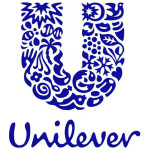
Anyone who has ever studied business and management or paid attention to the most common manufacturer of the goods at their local convenient store would know that the most popular brand of bread and butter would either be a brand label of P&G (Proctor and Gamble) or Unilever (previously known as Lever brothers); That is where Katz’s career started.
Katz’s resume speaks for itself; he was brought on board after the Genesis had launched. The fact that Rosen’s team was unable to secure the Mega Drive name was evident that they were far from on top of things.
Katz had little time to turn the tide in SEGA’s favor, and he worked quickly to create SEGA Entertainment Software R&D. Up until his arrival, SEGA of Japan was primarily doing all research and development where the Western wing was primarily a distribution office. With a functional software development set up, he worked with Shinobu Toyoda** to secure licenses such as hall of fame football player Joe Montana, effectively birthing SEGA Sports in the process. Additionally, he also secured the licence for moonwalking pop legend Michael Jackson.

With the licenses in place and software development on the way, he launched the company’s most popular marketing campaign “SEGA does what Nintendon’t.”
Yet, in spite of all his accolades, his services were quietly terminated by SEGA Chairman Nakayama in January 1991 and replaced by American Samurai Tom Kalinske.

Why?
From what I gather, Katz was more of a managing director than a president. He was a hardworking stiff; an employee. He worked under Rosen (vice chairman) and with Shinobu Toyoda – those two were the executives where as he didn’t really entertain the extreme vision of Chairman Nakayama to sell a million Genesis units or yell “Hayakumandai” (“million” in Japanese) every morning in an assembly.
Basically, he was never invested in the political drama that the East and West offices engaged in. Additionally, unlike his successors, he lacked the necessary speaking skills and pompous attitude that is required in politics. That said, his body of work speaks for itself.
Ken Horowitz of SEGA-16 interviewed him recently and asked what his opinion on all the mistakes SEGA made after his departure to which he responded:
“I didn’t keep close tabs on why SEGA lost their edge; I was in a post-SEGA era of my life.”
Post SEGA, he gave up on working under video game executives and started his own consultation firm, where he could simply guide executives instead of taking reign. He retired from the video game industry in 2008. Today, he volunteers at a business consultation and mentors enterprising entrepreneurs.
As with the Rosen Report, it is impossible to do justice to Katz’s contribution in even an extended blog post. To read the full story we urge you to pick up Service Games: Rise & Fall of SEGA; it is a story for the ages. The book also served as our primary reference for this report.
We also have a contest where we are giving away multiple copies of the book as well as T-shirts.
* Gene Lipkin and Bruce Lowery were hired as presidents before Katz.
** Shinobu Toyoda is another SEGA superstar who was the head of Sonic Team; hence Yuji Naka’s boss. He was also the bridge between SOJ and SOA in the formative years.


